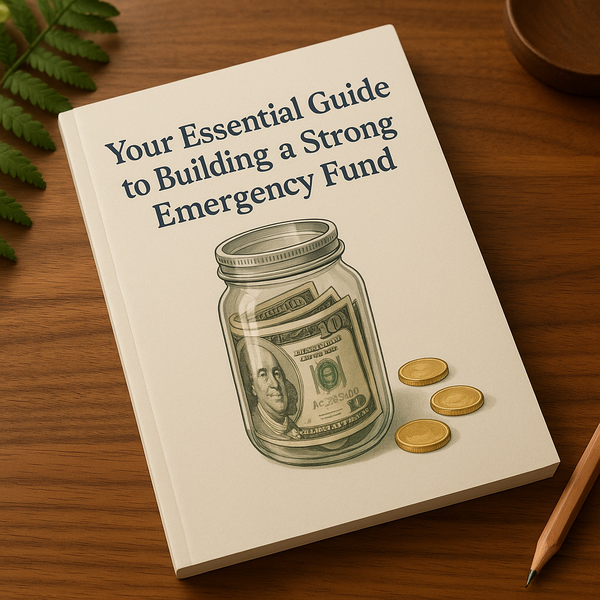
Embarking on the journey to financial security starts with a fundamental step: building an emergency fund. This financial cushion is your first line of defense against life's unexpected challenges, providing peace of mind and stability when you need it most. Think of it as your personal safety net, ready to catch you before minor bumps turn into major crises.
Why You Need an Emergency Fund
Life is unpredictable. Unexpected events like job loss, medical emergencies, or sudden home repairs can arise without warning, often bringing significant financial stress. Without an emergency fund, you might be forced to rely on credit cards with high interest rates or take out costly loans, potentially trapping you in a cycle of debt. An emergency fund acts as a buffer, allowing you to cover these unforeseen expenses without derailing your long-term financial goals or plunging into debt. It provides a sense of security and reduces anxiety, knowing you're prepared for the unexpected.
How Much Should You Save?
A commonly recommended goal is to save enough to cover 3 to 6 months of essential living expenses. Essential expenses include things like rent or mortgage payments, utilities, food, transportation, insurance premiums, and debt payments. The exact amount you need depends on your personal circumstances, such as job stability, number of dependents, and other financial obligations. If you have a less stable income or a family to support, aiming for the higher end of the 3-6 month range, or even more, might be prudent. Start by calculating your monthly essential expenses. This number multiplied by 3 to 6 (or more) months will give you your target emergency fund balance. Don't feel overwhelmed if this number seems large; building the fund is a process that takes time and consistent effort.
Where to Keep Your Emergency Fund
The primary goal for your emergency fund is accessibility and safety, not high returns. This money needs to be readily available when an emergency strikes. The best place is typically a separate savings account that is easily accessible but distinct from your everyday checking account. High-yield online savings accounts are popular choices because they offer slightly better interest rates than traditional brick-and-mortar banks, helping your money grow (or at least keep pace with inflation) a little faster, while still being liquid. Look for accounts that are FDIC insured (up to the legal limit) to protect your deposit. Avoid investing your emergency fund in the stock market or other volatile assets, as you could lose value just when you need the money most. The goal is preservation of capital and accessibility, not growth.
Strategies for Building Your Fund
Building an emergency fund takes discipline and a strategic approach. The first step is to create a budget if you don't already have one. A budget helps you understand where your money is going and identify areas where you can cut back to free up funds for savings. Look for non-essential expenses you can reduce or eliminate temporarily. Automate your savings by setting up automatic transfers from your checking account to your dedicated emergency fund savings account each payday. Treat this transfer like any other bill. Start small if you need to; even saving $20 or $50 a week adds up over time. Consider boosting your savings with windfalls like tax refunds, bonuses, or gifts. You could also consider a side hustle or selling unwanted items to accelerate your savings efforts. Make it a priority in your financial plan.
Making it a Habit
Consistency is key to building a substantial emergency fund. Once you've established a budget and set up automatic transfers, make checking in on your progress a regular habit. Review your budget periodically to ensure you're still on track and look for new opportunities to save. As your income increases or your expenses change, adjust your savings contributions accordingly. Think of saving for your emergency fund not as a sacrifice, but as an investment in your future peace of mind and financial stability. Celebrate milestones as you reach them – hitting your first month of expenses saved, then three, then six. This positive reinforcement can help maintain motivation.
Maintaining Your Fund
Once you've reached your savings goal (e.g., 3-6 months of expenses), your focus shifts from aggressively saving to maintaining that balance. This means resisting the urge to dip into the fund for non-emergencies. Clearly define what constitutes a true emergency for you (job loss, major medical bill, essential home repair) to avoid impulse spending from the fund. If you do need to use some of the money for a legitimate emergency, make replenishing it a top financial priority as soon as possible. Life circumstances can change, so it's a good idea to review your emergency fund target periodically, perhaps annually, to ensure it still aligns with your current essential expenses and financial situation. Keeping the fund separate and earmarked specifically for emergencies helps prevent accidental spending.
Building an emergency fund is a foundational element of sound financial planning. It requires commitment and discipline, but the security and peace of mind it provides are invaluable. By understanding its importance, setting a clear goal, choosing the right place to save, and implementing consistent strategies, you can build this vital financial safety net and protect yourself against the unexpected challenges life may bring.

